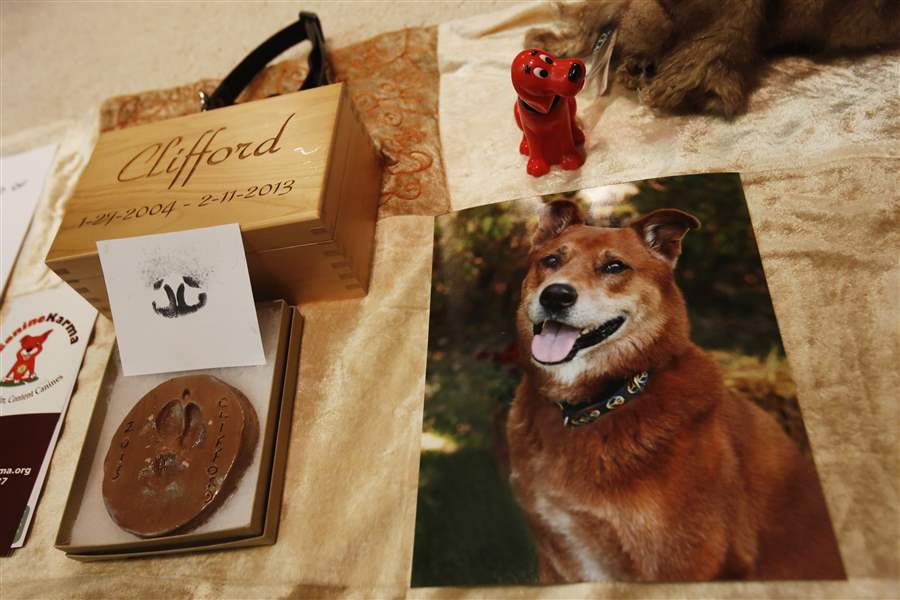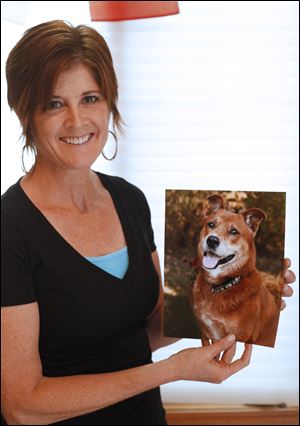
CRITTER CARE
Euthanasia often final act of love for ailing pet
Guidelines, options for tough decision
7/8/2013
Tina Ferner keeps a number of remembrances of Clifford. Ms. Ferner, who co-owns a dog-training facility, put together a guide to help make the difficult decision a little easier.
THE BLADE/KATIE RAUSCH
Buy This Image

Tina Ferner keeps a number of remembrances of Clifford. Ms. Ferner, who co-owns a dog-training facility, put together a guide to help make the difficult decision a little easier.
Tina Ferner knew her dog Clifford was dying of cancer.
She provided him with hospice care, including pain management, and she had a going-away party for him before she had her veterinarian euthanize him in her home.
“My main goal for him was to find the highest level of comfort for as long as possible, and when that was no longer possible, I wanted him to have a peaceful, painless passing,” Ms. Ferner said. “He was a good friend, and we shared a very strong bond. He deserved all of this.”
End-of-life decisions for pets are difficult to think about, but there are options. Pets suffering from a terminal illness or a combination of age-related illnesses can be euthanized at a veterinary clinic or at home. Their remains can be cremated, or their bodies can be returned to owners for home burial.
Owners who stay with their pets during the procedure can comfort the pet, but some find it too difficult and prefer that the vet does it without their presence.
Clifford was diagnosed with osteosarcoma at the end of December. He was 9 years old when he was euthanized on Feb. 11, barely six weeks after the diagnosis.
“I searched for resources to help us with end of life care and there was nothing I could find locally,” said the Holland resident.
She put together “Resources For End of Life Care,” a guide that she plans to offer to clients at Canine Karma, the Holland dog-training facility she owns. She hopes to find local veterinarians to offer the guide to clients.

When Tina Ferner realized the time had come to say good-bye to her 9-year-old Akita mix Clifford, who was suffering from osteosarcoma, she asked her veterinarian to come to her home in Holland. Ms. Ferner and her husband Michael Plewa, sang to the dog as he passed.
Ms. Ferner held a party to celebrate Clifford’s life on Jan. 27. She invited those who knew him to “come for a short pat or stay for the whole time.”
His quality of life continued to decline, and on Feb. 10, Ms. Ferner and her husband, Michael Plewa, decided to end his suffering. On Feb. 11, her veterinarian, Dr. Sue Savage, came to her home and euthanized the “big red dog” who had converted her from a “cat person” to a “dog person.”
Dr. Savage gave Clifford a drug to relax him before administering the euthanasia drug. Ms. Ferner and Mr. Plewa comforted Clifford during the process, including singing to him.
“Being his guardian and advocate and protector, he needed me to find the strength to allow him a peaceful passing,” Ms. Ferner said.
During her work with terminally ill humans, Ms. Ferner developed the Integrative Medicine Program at Mercy Cancer Centers that provides massage, yoga, guided imagery, and relaxation techniques for cancer survivors and their families.
Canine Karma has hired a licensed social worker and plans to offer grief counseling, support groups, and consultations for pet owners facing end-of-life decisions.
“If we can do it for people, we can do it for dogs,” she said.
When researching options for easing Clifford’s suffering, Ms. Ferner consulted with Dr. Alice Villalobos, a veterinarian who practices in Hermosa Beach, Calif., by phone.
Dr. Villalobos is a pioneer in the field of cancer care for companion animals and a founding member of the Veterinary Cancer Society. She has developed a quality-of-life scale for cats and dogs to help owners decide when it is time to euthanize.
The word euthanasia comes from the Greek, with “eu” meaning easy or good plus “thanatos,” meaning death. Euthanasia is literally the “easy or good death.”
Its intention is to end suffering and to do so in a peaceful, kind, and loving manner, Ms. Ferner said.
“It becomes the final act of love,” she said.
A quality-of-life scale may help everyone, especially those who are in denial about their pet’s illness, to face difficult issues, writes Dr. Villalobos in an article on her web site, pawspice.com.
Caretakers can use the scale to ask themselves if they are able to provide enough help to maintain an ailing pet properly, she writes.
“If we can create or restore a satisfactory level for our ailing companion animals, then we are justified in preserving the life of the ill pet during its steady decline toward death,” Dr. Villalobos writes.
The scale is designed to provide an easy guideline for assessment of the pet so that family members can maintain a rewarding relationship and nurture the human-animal bond.
“The scale offers some objectivity while remaining sensitive to the caregiver’s wishes,” she said. “It will relieve guilt feelings and engender the support of the veterinary team to actively help in the care and decision-making for end of life.”
Things to consider on the scale include hurt, hunger, hydration, hygiene, happiness, mobility, and more good days than bad. Adequate pain control and breathing ability are of top concern. If the pet can’t breathe properly, nothing else matters, according to the scale.
When bad days outnumber the good, quality of life might be too compromised. When a healthy human-animal bond is no longer possible, the caregivers must be made aware that the end is near.
The decision for euthanasia needs to be made if the pet is suffering, Dr. Villalobos writes.The complete scale for both dogs and cats can be found at: https://tinyurl.com/qualityoflifescale.
Ms. Ferner said she hopes to pass on what she learned during Clifford’s end-of-life care and euthanasia.
“I hope all of this heartache and research can help others,” she said.
Contact Tanya Irwin at: tirwin@theblade.com, 419-724-6066, or on Twitter @TanyaIrwin.